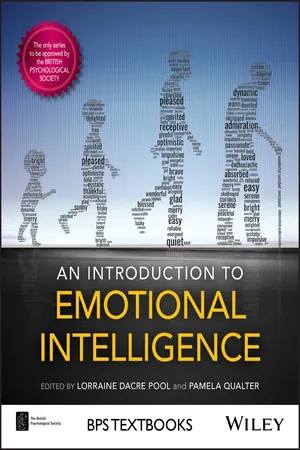
- English
- ePUB (mobile friendly)
- Available on iOS & Android
An Introduction to Emotional Intelligence
About This Book
Bridges the gap between the scholarly literature and "pop-psych" books on EI
Emotional Intelligence (EI) has become a topic of vast and growing interest worldwide and is concerned with the ways in which we perceive, identify, understand, and manage emotions. It is an aspect of individual difference that can impact a number of important outcomes throughout a person's lifespan. Yet, until now there were no authoritative books that bridge the gap between scholarly articles on the subject, often published in obscure professional journals, and the kind of books found in the "pop-psych" sections of most large bookstores. This book fills that gap, addressing the key issues from birth through to old age, including the impact of EI on child development, social relationships, the workplace, and health. It is a useful introduction to the academic study of EI, including its history as a concept. Featuring contributions by an international team of EI researchers, this thought provoking and informative book offers students, educators, mental health professionals, and general readers a comprehensive, critical, and accessible introduction to state-of-the-art EI theory and research.
From the historical origins of EI to its contemporary applications across an array of domains, An Introduction to Emotional Intelligence explores what the research evidence tells us about it, why it is important, and how it is measured. Throughout each chapter any potentially tricky words or concepts are highlighted and explained. And, most chapters feature activities to spur further reflection on the subject matter covered as well as ideas on how to apply aspects of EI to various questions or problems arising in the readers' lives.
- Features contributions from expert authors from around the world with experience of researching and teaching EI theory and practice
- Makes EI concepts, foundations, research, and theory accessible to a wider audience of readers than ever before
- Explores EI's roots in psychological thinking dating back to early 20 th century and considers the reasons for its widespread popularity in contemporary times
- Reviews the latest research into the constructs of ability EI and trait EI and their validity in relation to health, wellbeing, social relationships, academic, and work performance
An Introduction to Emotional Intelligence is fascinating and informative reading and a source of practical insight for students of psychology, management and leadership, education, social work and healthcare, and those working in education, health settings and in psychological counseling professions.
Frequently asked questions
Information
1
Emotional Intelligence: A Brief Historical Introduction
1.1 INTRODUCTION
1.2 THE EMERGENCE OF A HIGH‐PROFILE CONSTRUCT

1.2.1 Where does the term EI come from?
IQ: Intelligence quotient
1.3 EMOTIONAL INTELLIGENCE AND THE CURRENT “EMOTIONAL ZEITGEIST”
Table of contents
- Cover
- Preface: Introduction by the Editors
- 1 Emotional Intelligence
- 2 Trait and Ability Conceptualizations of Emotional Intelligence
- 3 Emotional Self‐Efficacy
- 4 Measuring Emotional Intelligence
- 5 An Overview of Emotional Intelligence in Early Childhood
- 6 Emotional Intelligence and Emotional Education in the School Years
- 7 Emotional Intelligence in Adolescence and Early Adulthood
- 8 Emotional Intelligence in Higher Education
- 9 Emotional Intelligence and the Workplace
- 10 Emotional Intelligence for Health Care Professions – Professional Compathy
- 11 Emotional Intelligence, Stress, and Health
- 12 Emotional Intelligence and Ageing
- References
- Index
- End User License Agreement